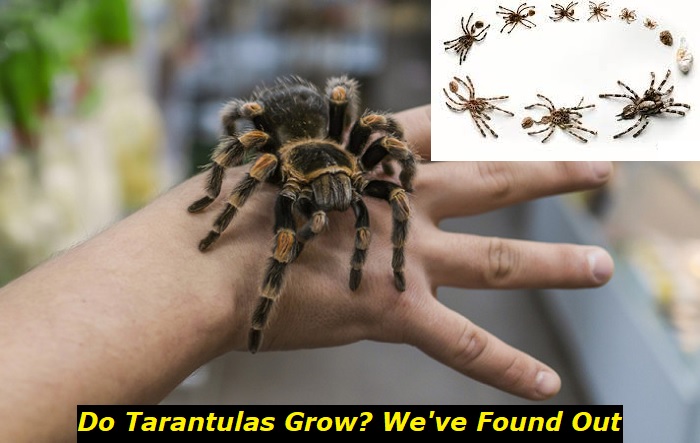Tarantulas have armors that do not change size, expand, or grow. So, do they grow?
For anyone interested in keeping a tarantula at home, knowing this information is crucial. This animal has a unique way of growing.
Having exoskeletons only means that their growth is somehow– restricted. This outer skin is not flexible to stretch or expand. So, like any other arachnid or insect, tarantulas need to shed off their skin to stretch out their legs. They must form new skin to protect their growing body.

To answer your question, tarantulas grow. And their growth is not so different from other spiders. If you want to know more about how tarantulas grow, read on.
Factors that Affect Tarantula’s Growth
Before we discuss how they grow, let’s talk about the factors that help tarantulas grow.
1) Temperature
As a burrowing species, tarantulas need warmer temperatures. Although some species may need specific temperatures, this one grows and lives in warmer climates.
Warm temperatures play a significant role in their well-being and development. Warm temperatures, along with humidity, also support their molting process. Aside from that, this type of temperature stimulates digestion and metabolism.
If you’re going to house a tarantula, they need temperatures of about 24 to 27 °C (75 to 80°F) to thrive. You need to provide some humidity in their glasshouse by misting them.
2) Food
If there’s any factor that makes a huge impact on a tarantula’s growth, it would be food.
Tarantulas tend to grow slower naturally. And trying to speed up their growth may affect their health. But we cannot deny that frequent feeding helps them grow faster.
Providing them with the prey of different sizes and variety offer tarantulas a balanced diet since they will have unique sets of nutrients. However, eating bigger or smaller prey could affect their health.
The appropriately-sized prey provides better nutrition. Bigger ones may cause them injury, while smaller ones may provide insufficient nutrition.
Feeding the prey with a nutritious diet also helps your tarantula feed on nutrient-rich prey.
Note that younger tarantulas eat more frequently than adult ones. This is the reason why the young ones molt more often.
3) Molting Frequency
The only way for tarantulas to grow is to shed their old skin. When tarantulas shed off their old skin, they replace it with a newer and bigger exoskeleton that will shelter the newly-grown body and legs of a tarantula. However, molting is complicated for tarantulas to complete. In this stage, they are vulnerable.
The completion of the molting is crucial to their growth and survival. It indicates positive and healthy growth and development if the tarantula is consistently molting successfully.
4) Stress and handling
Stress and handling can negatively affect the tarantula’s growth and development. When these creatures undergo stress, they may refuse to eat, which results in inadequate nutrition needed for growth.
Especially when they are molting, they need no intervention from external forces. External forces can disturb them when molting.
5) Species
Different species have different timelines of growth. Some species of immature tarantulas will grow faster, while some will grow slower. If you are keeping baby tarantulas as pets, you must realize that some will be there for a few years while others may even last for decades.
The Stages of Tarantula’s Growth
Tarantulas grow in different stages. As any spider does, tarantulas start as an egg and become a spiderling when they hatch. Eventually, they become adults as they grow.
Tarantulas have an interesting way of reproducing. Different species have different mating seasons. During this season, after rainstorms, you will see a lot of male tarantulas wandering around to search for a female. When he finds one, the male tarantula shows up on her burrow by scent and spreads a thin web on its opening. If the female tarantula likes the male tarantula, she will go out from her burrow, and mating happens.
- Eggs
After mating, the female tarantula goes back home, caring for her eggs. She will weave a sheet of web to lay hundreds to thousands of eggs. When it is sunny, she will bring her eggs into her burrow’s lip to warm them up under the sun. She will continue warming up those eggs until they fully hatch. They may hatch between two to sixteen weeks. After hatching, they will stay in their mother’s burrow for a few weeks until they are ready to find themselves a home.
- Spiderlings
Baby tarantulas experience their first molting while still in the web sac made by their mother. After one week, tarantula spiderlings will molt for the second time. After this, spiderlings will start looking for their food.
The growth of tarantula spiderlings depends on their species and a few other factors mentioned above. They molt rapidly when fed frequently and when they live in warmer temperatures.
Some species molt monthly, while slow-growing tarantulas molt every six months.
Some examples of fast-growing tarantulas are orange baboons and Indian ornamentals. They can mature in as short as two years. The Brazilian white knee loves to eat a lot and grows much faster due to frequent eating.
The longest-living tarantula, the Brachypelma tarantula, grows slowly. On some occasions, they might live for more than twenty years.
- Adult
Younger tarantulas molt more frequently than adults. In general, tarantulas can reach maturity as early as two years. In the adult stage, tarantulas are ready for mating. Naturally, female tarantulas live longer than males.
Males live up to twelve years, while females live twice as much as males. Males typically live shorter because most of them die after mating. There’s a myth about female tarantulas eating male ones after mating. But most males die because of starvation after mating.
Another fact: some wild tarantulas live up to thirty years.
How do Tarantulas Grow?
Going back to our first question, tarantulas have an exoskeleton that does not change in size. Because their outer skin does not expand or stretch, they cannot grow. Unlike our skin (which develops with the bones), tarantula’s outer skin cannot grow with their body. Their organs and entire body are shielded by a rigid, yet flexible skin that allows movement while being protected.
But because this shield doesn’t grow, they need to support their growing body by molting, otherwise known as ecdysis.
What is Ecdysis?
All spiders, including tarantulas, molt or shed their skin periodically, depending on their species. The process where they shed off their skin is called ecdysis or molting.
Here’s what happens to a tarantula’s body when molting.
Premolt: the coexistence of new and old exoskeleton
When its body needs to molt, it will secrete hormones that enable molting. The inner skin layer of the tarantula will start to break down. This layer is elastic, and the tarantula’s body will reabsorb it while the old exoskeleton continues to protect its body and while it forms the new exoskeleton. The developing new exoskeleton is larger than the previous one because it will house the grown body of the new tarantula.
Initially, the newly-formed exoskeleton is soft and folds under the shield of the old one. At this stage, the tarantula is so weak. The nerves that used to link to the old skeleton will detach slowly. For this reason, the tarantulas would not respond or get attracted to any prey offered.
If the pre-molting tarantula does not eat your prey, remove it. The spider has to remain undisturbed during molting. The least you can do is add water regularly to its water dish. Other else, you should not touch a tarantula in its pre-molt or molting stage.
The Crucial Stage of Molting
When the new exoskeleton is fully-developed, it will start taking in the enlarging body of the tarantula, and the old one breaks slowly. As the old exoskeleton breaks, its body continues to grow and fill the new exoskeleton until it is hard enough to shell its entire body.
During this time, the tarantula is too weak to defend itself. Any form of disturbance can injure the tarantula.
You can easily identify a molting tarantula when it flips or lay on its back or sideways. Some tarantulas web a molting cradle. Never touch this because the spider is extremely weak.
Disturbance kills molting tarantulas. And some tarantulas do get stuck on their molts. Once it does, it may injure them. Injured tarantulas during molting usually die. And intervention does not help.
When a tarantula has some parts already out of the outer skin but some still stuck for hours and without progress, it is probably stuck on its molt. You can try dampening this part with glycerin or soap water. But
This process completes within fifteen minutes up to an entire day, depending on the size and age of the spider. Younger tarantulas molt faster compared to older ones.
Post Molting
After shedding off its old skin, the new exoskeleton is not hard enough. The tarantula may not eat yet. It might take a week before it regains appetite. At this stage, fill up the water dish to keep it hydrated.
How Fast Do Tarantulas Grow?
In general, tarantulas grow within two to five years. In this stage, they could change their skin every two or three months or even every six months. Larger tarantulas molt slower and fewer than younger tarantulas.
Sometimes, the frequency depends on their species. Some species molt faster. Also. their molting frequency depends on the environment. Warmer climates help the molt faster. The sad reality for male tarantulas is they stop molting when they reach maturity, while female tarantulas still molt even after this stage.
- Pacman Frog Looks Deflated – What’s Wrong and What to Do? - August 7, 2023
- How to Put Snake Back in Cage after Feeding? Important Concerns - July 31, 2023
- Repta Boost: Instruction, Considerations, Ways to Use - July 24, 2023



